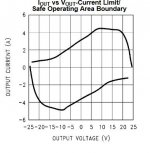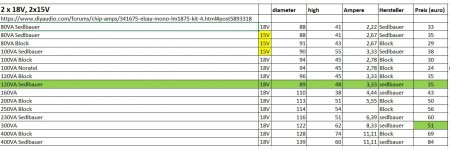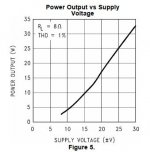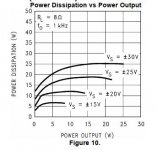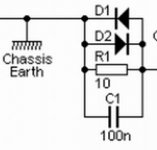Big ! but nice ( Pricey) case for for a pair of less than 1/2 a credit card sized 2$ amp kit pcbs. Is the immediate/first impression.
Elliot suggests that a 50 va Tx is adequate, while 150va is overkill and anything larger is completely unwarranted.
First pix has only one side/rail portion of the Diyshop PS pcb.
IF wanting to do a single (pseudo twin rail) from a dc source supply... a pair of electros & resistors is all that's needed. Quite compact actually.
Elliot suggests that a 50 va Tx is adequate, while 150va is overkill and anything larger is completely unwarranted.
First pix has only one side/rail portion of the Diyshop PS pcb.
IF wanting to do a single (pseudo twin rail) from a dc source supply... a pair of electros & resistors is all that's needed. Quite compact actually.
Last edited:
Hi Bare
hi rabbitz
thanks for your comments.
yes this case i "oversized" but if i want to go ahead with the next amp - after lm1875 -e.g. lmxxx or TDA7294 etc... i want to re use this case.
i read in the big gainclone thread Andrew T. mentioned that the 50VA trani is too small for one channel because of the regulation is at small tranis bigger because of 1 amp current the transfomer start to decrease its voltage = regulation/saturation is starting...............etc.correct?
chris
hi rabbitz
thanks for your comments.
yes this case i "oversized" but if i want to go ahead with the next amp - after lm1875 -e.g. lmxxx or TDA7294 etc... i want to re use this case.
i read in the big gainclone thread Andrew T. mentioned that the 50VA trani is too small for one channel because of the regulation is at small tranis bigger because of 1 amp current the transfomer start to decrease its voltage = regulation/saturation is starting...............etc.correct?
chris
Yess.. Regulation improves with increasing VA.. some.
But it's also a diminishing returns situation.
You can certainly fit as Big a Tx as you wish.. but case size does become an issue ... 100 to 125 is all I'd fit.
Personally I'd set future aspirations to a DIY Firstwatt amp.
Arguably as good as it gets amp quality wise ... and actually surprisingly affordable to build. Mine ran about 4X what my toy 1875 build has.
Cases however are an open issue.. but the DIY audio shop has decent case prices should you choose to buy rather than build a case
You 'could' recycle your case to house an Amp Camp Amp ?
But it's also a diminishing returns situation.
You can certainly fit as Big a Tx as you wish.. but case size does become an issue ... 100 to 125 is all I'd fit.
Personally I'd set future aspirations to a DIY Firstwatt amp.
Arguably as good as it gets amp quality wise ... and actually surprisingly affordable to build. Mine ran about 4X what my toy 1875 build has.
Cases however are an open issue.. but the DIY audio shop has decent case prices should you choose to buy rather than build a case
You 'could' recycle your case to house an Amp Camp Amp ?
Last edited:
Hi bare
Yes i read about Class a amps and yes they improve with bigger housings. 4u is recommended for e.g. F5 or M2. The Cooling at higher bias is important.
My Brother Build a F5 but with a re used case of an AV Receiver and 2nd hand heat sinks.
But i go Step by Step...
Chris
Yes i read about Class a amps and yes they improve with bigger housings. 4u is recommended for e.g. F5 or M2. The Cooling at higher bias is important.
My Brother Build a F5 but with a re used case of an AV Receiver and 2nd hand heat sinks.
But i go Step by Step...
Chris
IF wanting to do a single (pseudo twin rail) from a dc source supply... a pair of electros & resistors is all that's needed. Quite compact actually.
Do tell as I've used and very familiar with the TLE2426, virtual ground circuits and ESP P43 for opamp circuits but not familiar with ones for power amps.
Thanks to bare´s input about the transformer i recheck the 80VA or 100VA .
yes they are smaller:
sedlbauer toriodal transformers check at conrad-eelctronic and aliexpress...ali is not cheaper
80VA diam. 88mm high 41mm cost about 33 euro
120VA diam. 89mm high 48 mm cost about 35 euro
160VA diam. 110mm high 38mm cost about 43 euro
in my housing the high is not an issue but every mm i can save its good to have more space - so a good trani is 120VA version.
the producer BLOCK/noratel make the tranis compared to the sedlbauer always bigger in diameter
chris
yes they are smaller:
sedlbauer toriodal transformers check at conrad-eelctronic and aliexpress...ali is not cheaper
80VA diam. 88mm high 41mm cost about 33 euro
120VA diam. 89mm high 48 mm cost about 35 euro
160VA diam. 110mm high 38mm cost about 43 euro
in my housing the high is not an issue but every mm i can save its good to have more space - so a good trani is 120VA version.
the producer BLOCK/noratel make the tranis compared to the sedlbauer always bigger in diameter
chris
Hi rabbitz
hi Bare
now i looked at a very important figure in the datasheet. the max Vout and the relation with the current limit - Figure 11 page 5.
i looked at a very important figure in the datasheet. the max Vout and the relation with the current limit - Figure 11 page 5.
now for me its more clear what you mean

the idea why some guys use a "just" 15VAC output voltage. 15 *1,4 = 21Vdc. so i interpret the diagram that the current limit is kick in about 18-19V.
to avoid the max power on the chip at 4R impedance the trani could be 15*3amp => 45 - 60VA
correct?
chris
hi Bare
now
now for me its more clear what you mean
the idea why some guys use a "just" 15VAC output voltage. 15 *1,4 = 21Vdc. so i interpret the diagram that the current limit is kick in about 18-19V.
to avoid the max power on the chip at 4R impedance the trani could be 15*3amp => 45 - 60VA
correct?
chris
Attachments
Sorry, I missed a part of the thread.
I am not sure that having the transformer so close to the channels is beneficial due to the noise that the transformer can induce.
As for the supply voltage I would also opt for a 15-0-15 transformer if you are not going to regulate the output voltage. With 21Vdc I think you can live happily
Off topic: Are you professional? What team do you run on? I also practice cycling.
I am not sure that having the transformer so close to the channels is beneficial due to the noise that the transformer can induce.
As for the supply voltage I would also opt for a 15-0-15 transformer if you are not going to regulate the output voltage. With 21Vdc I think you can live happily
Off topic: Are you professional? What team do you run on? I also practice cycling.
Sorry, I missed a part of the thread.
I am not sure that having the transformer so close to the channels is beneficial due to the noise that the transformer can induce.
As for the supply voltage I would also opt for a 15-0-15 transformer if you are not going to regulate the output voltage. With 21Vdc I think you can live happily
Off topic: Are you professional? What team do you run on? I also practice cycling.
1 after Trani = 15V 0- 15 you have AC Voltage so you have to use a rectifier and some caps to build a stable DV volateg . the factor is about AC voltage * 1,4 after rectifier and caps.
2 no i am not a professional - its a hobby since 10 years and with riding to office and afterworks its fine for practice... i did 2 years some not successfully MTB hobby races - about 5000 -6000km per year 100.00 uphill
so i am 48 so no Championship planed
chris
hi Blackdod
I try to build a psu for my case so the internal dimensions are tight but i want to re use this amp for a stronger amp e.g. TDA7294. so this is the reason i check with bare and rabbitz my opportunities to achieve this. (project merge... )
)
post 31 by rabbitz is here very helpful.
so smal cheap case - 15-0-15 trani with suffiecient psu and 2 channles - no preamp and its fine for enough power at home.
if you want to go to the limit af the chip (50V @ 8ohm impedance) you need to be mor carefully about psu , limit of the chip + heatsink , housing cooling
i am not in rush..i want to be clear what i am doing...... and learn ..
and learn ..
chris
I try to build a psu for my case so the internal dimensions are tight but i want to re use this amp for a stronger amp e.g. TDA7294. so this is the reason i check with bare and rabbitz my opportunities to achieve this. (project merge...
post 31 by rabbitz is here very helpful.
so smal cheap case - 15-0-15 trani with suffiecient psu and 2 channles - no preamp and its fine for enough power at home.
if you want to go to the limit af the chip (50V @ 8ohm impedance) you need to be mor carefully about psu , limit of the chip + heatsink , housing cooling
i am not in rush..i want to be clear what i am doing......
chris
I use large boxes and play with the transformer position before deciding the final position to avoid induced noises.
I have seen several amplifiers finished here in really small boxes and one of the details that surprise me is that no one has had problems with the noise produced by the transformer. (Hummmmm)
I suppose that when using headphones, this type of noise is more present than with speakers or this chips family is more immune to noises that other circuits.
I have seen several amplifiers finished here in really small boxes and one of the details that surprise me is that no one has had problems with the noise produced by the transformer. (Hummmmm)
I suppose that when using headphones, this type of noise is more present than with speakers or this chips family is more immune to noises that other circuits.
I use large boxes and play with the transformer position before deciding the final position to avoid induced noises.
I have seen several amplifiers finished here in really small boxes and one of the details that surprise me is that no one has had problems with the noise produced by the transformer. (Hummmmm)
I suppose that when using headphones, this type of noise is more present than with speakers or this chips family is more immune to noises that other circuits.
hi
a good way to avoid hum is to move the transformers outlets - the area where the cable came out as far away from the amps board and other boards.
grounding the chassis - earth....the anodizied cases = black is not a good conductor if youscrew a GND-Earth connection - you have to scratch away from this surface to get a good electrical contact
chris
Last edited:
I try and place the heatsink between the amp modules and the transformer but aluminium I believe is not the best shielding material. I think it's more important to get the wiring layout right as well as twisting the wires, especially the AC.
There are 2 things that have helped with hum issues. One is grounding the heatsink and the other is a 10R resistor with parallel reversed diodes on the ground line from the power supply back to the earth. The fig from ESP below shows the method but I've never used the 100nF cap. Some builders have the power supply floating with no ground from the power supply going back to earth but even though it might reduce hum, it's not a safe idea IMO.
On anodised or painted cases I machine a flat surface to expose raw metal for the earth bolt or screw.
Never had a hum issue in power amps but pre amps and low level signal circuits can be a pain as well as volume pots.
Will be interesting to see how this one goes with hum as I'm using plastic cases and even though the power supply is in a different case, there's no shielding at all. But then again it's no different to having it all laid out on the work bench.
There are 2 things that have helped with hum issues. One is grounding the heatsink and the other is a 10R resistor with parallel reversed diodes on the ground line from the power supply back to the earth. The fig from ESP below shows the method but I've never used the 100nF cap. Some builders have the power supply floating with no ground from the power supply going back to earth but even though it might reduce hum, it's not a safe idea IMO.
On anodised or painted cases I machine a flat surface to expose raw metal for the earth bolt or screw.
Never had a hum issue in power amps but pre amps and low level signal circuits can be a pain as well as volume pots.
Will be interesting to see how this one goes with hum as I'm using plastic cases and even though the power supply is in a different case, there's no shielding at all. But then again it's no different to having it all laid out on the work bench.
Attachments
Last edited:
There are 2 things that have helped with hum issues. One is grounding the heatsink and the other is a 10R resistor with parallel reversed diodes on the ground line from the power supply back to the earth. The fig from ESP below shows the method but I've never used the 100nF cap.
Is that ground from the transformer or ground post-PSU?
Do you have a link to the ESP-page?
- Home
- Amplifiers
- Chip Amps
- eBay mono LM1875 kit
